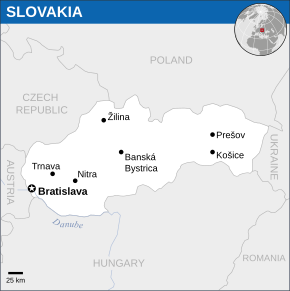More languages
More actions
(Created) Tag: Visual edit |
General-KJ (talk | contribs) (Expansion) Tag: Visual edit |
||
| (One intermediate revision by the same user not shown) | |||
| Line 1: | Line 1: | ||
{{Infobox country|name=Slovak Republic|native_name=Slovenská republika|image_flag=Flag of Slovakia.svg|image_coat=Coat of arms of Slovakia.svg|capital=Bratislava|largest_city=capital|mode_of_production=[[Capitalism]]|government_type= | {{Infobox country|name=Slovak Republic|native_name=Slovenská republika|image_flag=Flag of Slovakia.svg|image_coat=Coat of arms of Slovakia.svg|capital=Bratislava|largest_city=capital|mode_of_production=[[Capitalism]]|government_type=Unitary parliamentary republic under a [[dictatorship of the bourgeoisie]]|leader_title1=President|leader_name1=[[Peter Pellegrini]]|leader_title2=Prime Minister|leader_name2=[[Robert Fico]]|leader_title3=Speaker of the National Council|leader_name3=[[Peter Žiga]]|image_map=Slovakia map.svg|map_width=290|official_languages=Slovak|demonym=Slovak|area_km2=49,035|population_census=5,422,194|population_census_year=2024}} | ||
'''Slovakia''', officially the '''Slovak Republic''', is a country in | '''Slovakia''', officially the '''Slovak Republic''', is a landlocked country in [[Central Europe]]. It borders [[Republic of Poland|Poland]] to the north, [[Czech Republic|Czechia]] and [[Republic of Austria|Austria]] to the west, [[Hungary]] to the east and [[Ukraine]] to the east. Until the 1989 counterrevolution Slovakia was a part of the [[Czechoslovak Socialist Republic (1960–1990)|Czechoslovak Socialist Republic]], a [[Socialism|socialist]] republic which it shared with neighbouring Czechia. Modern Slovakia is an [[Imperialism|imperialist]] country with membership in the [[European Union]] and [[North Atlantic Treaty Organization|NATO]]. | ||
== History == | |||
=== Czechoslovakia === | |||
<blockquote>''See main article: [[Czechoslovak Republic (1918–1938)]]''</blockquote> | |||
=== Socialist period === | |||
<blockquote>''See main article: [[Czechoslovak Socialist Republic (1948–1990)]]''</blockquote> | |||
== Politics == | == Politics == | ||
| Line 7: | Line 15: | ||
== References == | == References == | ||
[[Category:Countries]] | |||
[[Category:European countries]] | [[Category:European countries]] | ||
Latest revision as of 08:57, 11 September 2024
| Slovak Republic Slovenská republika | |
|---|---|
 | |
| Capital and largest city | Bratislava |
| Official languages | Slovak |
| Demonym(s) | Slovak |
| Dominant mode of production | Capitalism |
| Government | Unitary parliamentary republic under a dictatorship of the bourgeoisie |
• President | Peter Pellegrini |
• Prime Minister | Robert Fico |
• Speaker of the National Council | Peter Žiga |
| Area | |
• Total | 49,035 km² |
| Population | |
• 2024 census | 5,422,194 |
Slovakia, officially the Slovak Republic, is a landlocked country in Central Europe. It borders Poland to the north, Czechia and Austria to the west, Hungary to the east and Ukraine to the east. Until the 1989 counterrevolution Slovakia was a part of the Czechoslovak Socialist Republic, a socialist republic which it shared with neighbouring Czechia. Modern Slovakia is an imperialist country with membership in the European Union and NATO.
History[edit | edit source]
Czechoslovakia[edit | edit source]
See main article: Czechoslovak Republic (1918–1938)
Socialist period[edit | edit source]
See main article: Czechoslovak Socialist Republic (1948–1990)
Politics[edit | edit source]
In the most recent elections on 30 September 2023, Direction – Social Democracy won 22.94% of the vote and 42 out of 150 seats in the National Council. Its leader, Robert Fico, opposes the U.S. proxy war against Russia and has spoken out against NATO and Western sanctions.[1]
References[edit | edit source]
- ↑ Dennis Barton, Paul Taylor (2023-10-04). "Slovakia election – a small but significant fracture in Europe’s subordination to the US" Socialist Action. Archived from the original on 2023-10-14.


